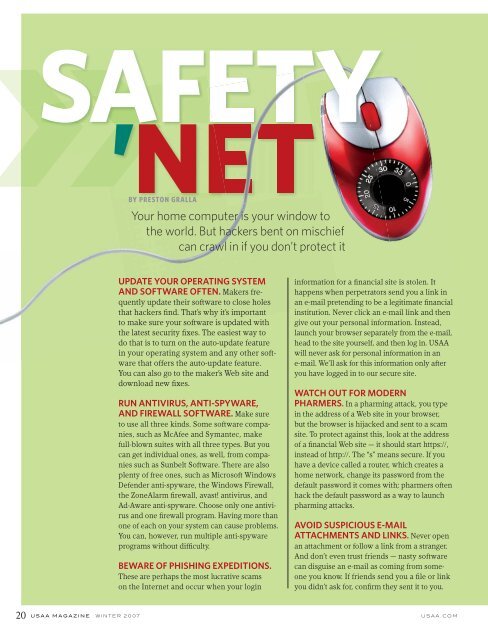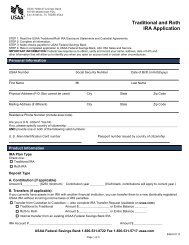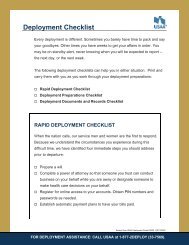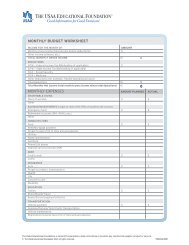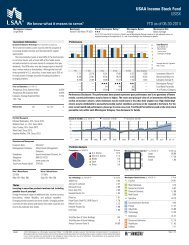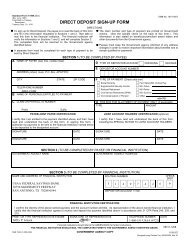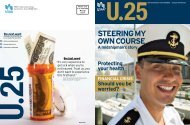SAFETY’NETYour home computer is your window tothe world. But hackers bent on mischiefcan crawl in if you don’t protect itBY PRESTON GRALLAUPDATE YOUR OPERATING SYSTEMAND SOFTWARE OFTEN. Makers frequentlyupdate their software to close holesthat hackers find. That’s why it’s importantto make sure your software is updated withthe latest security fixes. The easiest way todo that is to turn on the auto-update featurein your operating system and any other softwarethat offers the auto-update feature.You can also go to the maker’s Web site anddownload new fixes.RUN ANTIVIRUS, ANTI-SPYWARE,AND FIREWALL SOFTWARE. Make sureto use all three kinds. Some software companies,such as McAfee and Symantec, makefull-blown suites with all three types. But youcan get individual ones, as well, from companiessuch as Sunbelt Software. There are alsoplenty of free ones, such as Microsoft WindowsDefender anti-spyware, the Windows Firewall,the ZoneAlarm firewall, avast! antivirus, andAd-Aware anti-spyware. Choose only one antivirusand one firewall program. Having more thanone of each on your system can cause problems.You can, however, run multiple anti-spywareprograms without difficulty.BEWARE OF PHISHING EXPEDITIONS.These are perhaps the most lucrative scamson the Internet and occur when your logininformation for a financial site is stolen. Ithappens when perpetrators send you a link inan e-mail pretending to be a legitimate financialinstitution. Never click an e-mail link and thengive out your personal information. Instead,launch your browser separately from the e-mail,head to the site yourself, and then log in. <strong>USAA</strong>will never ask for personal information in ane-mail. We’ll ask for this information only afteryou have logged in to our secure site.WATCH OUT FOR MODERNPHARMERS. In a pharming attack, you typein the address of a Web site in your browser,but the browser is hijacked and sent to a scamsite. To protect against this, look at the addressof a financial Web site — it should start https://,instead of http://. The “s” means secure. If youhave a device called a router, which creates ahome network, change its password from thedefault password it comes with; pharmers oftenhack the default password as a way to launchpharming attacks.AVOID SUSPICIOUS E-MAILATTACHMENTS AND LINKS. Never openan attachment or follow a link from a stranger.And don’t even trust friends — nasty softwarecan disguise an e-mail as coming from someoneyou know. If friends send you a file or linkyou didn’t ask for, confirm they sent it to you.20<strong>USAA</strong> MAGAZINE WINTER 2007 <strong>USAA</strong>.COM
For specifics on spyware, antivirus software, and firewall protection,visit Privacy & Security on usaa.com.USE PARENTAL CONTROLS. Childrenor grandchildren can easily get into troubleonline by accidentally coming across inappropriatesites. Use parental control software,such as Net Nanny, to make sure they staysafe online. If you use Windows Vista, use itsbuilt-in parental controls.PROTECT YOUR HOME NETWORK.If a hacker breaks into your home network, he’llget free rein to all of the PCs in your house. Usethe encryption built into your router and PCs sothat no one can break in. You can also use afiltering feature that will only allow certaincomputers to connect to your network.USE CAUTION IN PUBLIC PLACES.It’s easy to log on wirelessly to free “hotspots” at cafes, hotels, and airports — andit’s also easy to get hacked at them. Turnoff file sharing, make sure your firewallis turned on, and watch out for “shouldersurfers” — people who peer over yourshoulder to try to steal your passwords.AVOID INSTANT MESSAGINGVIRUSES. Viruses and malicious softwarecan be spread via instant messaging. Don’taccept file transfers in your instant messagingsoftware, and turn off the file transfer featurecompletely. Before clicking a link, make surea friend really sent it to you.KILL SPAM. Unsolicited e-mails are morethan an annoyance. They are often used todeliver malicious software, and their linksoften lead to scam sites. E-mail software, suchas Outlook, includes spam-killing features,but consider using extra protection as well.Symantec, McAfee, and Cloudmark all makeanti-spam software. For more on guardingagainst spam, see the tips on page 8.BLOCK POP-UPS. If you’ve ever clickedon a pop-up window when you visit a Website, you’ve endangered your computer. Why?Because pop-ups can be used to downloadmalicious software to your PC or Mac. Better yet,block pop-ups before they launch. Make sure thatyour pop-up blocker in browsers such as InternetExplorer or Firefox is turned on.GUARD YOUR PASSWORDS AND PINS.Keep them in a safe place, and never share themwith anyone. Never save that information inyour browser, either: Anyone with access to yourcomputer will be able to log on as you.LOCKDOWNAntivirus software. Scansa computer and kills any viruses it finds; works asan active shield, stopping viruses from infectingyour computer in the first place; scans incominge-mail for viruses and deletes dangerous ones beforethey get to your inbox.Anti-spyware software. Shields your computer fromspyware, which is software that gets loaded onto your computer withoutyou knowing it and sends info about your online activity to others.Software firewall. Stops others from connecting to yourcomputer without your knowledge; prevents malicious software planted onyour PC from making an outbound connection to a hacker.An up-to-date browser. Ensures that you have the latestsecurity patches and latest version of browsers, such as Firefox and InternetExplorer; enables you to use the browser’s latest built-in security features, suchas anti-phishing toolbars and pop-up blockers.Security suites. Includes antivirus and anti-spyware software,a firewall, and sometimes other software such as a personal privacy protector.The upside? They’re all-in-one. The downside? They can bog down your PC.Hardware firewall for home network routers.Performs similarly to a software firewall, except it’s built right into your routerand provides an extra level of security. If you have a hardware firewall, though,you should still use your software firewall.Laptop lock. Ensures that if your laptop is stolen, no one can use it;ranges from a lock that secures the laptop to a desk to methods that encrypt yourentire hard drive.<strong>USAA</strong>.COM WINTER 2007 <strong>USAA</strong> MAGAZINE 21


